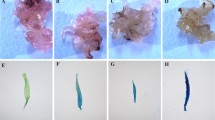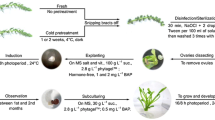Abstract
A major factor affecting spring canola (Brassica napus) production in Canada is killing frosts during seedling development in the spring and seed maturation in the fall. The objective of this study was to explore the possibility of producing spring canola lines with mutations that have altered biochemical pathways that increase cold tolerance. The approach was to generate UV point mutations in cultured microspores followed by chemical in vitro selection of individual mutant microspores or embryos resulting in measurable alterations to various biochemical pathways with elevated levels of key defense signaling molecules such as, salicylic acid (SA), p-Fluoro-d,l-Phenyl Alanine (FPA), and jasmonic acid (JA). In addition, since proline (Pro) is known to protect plant tissues in the cold-induced osmotic stress pathway, mutants that overproduce Pro were selected in vitro by using three Pro analogues: hydroxyproline (HP), azetidine-2-carboxylate (A2C); and, 3,4-dehydro-d,l-proline (DP). Of the 329 in vitro selected mutant embryos produced, 74 were identified with significant cold tolerance compared to their donor parents through indoor freezer tests at −6°C, and 19 had better winter field survival than winter canola checks. All chemically selected mutant doubled haploids with increased cold tolerance compared well with parent lines for all seed quality and agronomic parameters. Development of increased frost tolerant cultivars should allow for spring canola to be produced in western Canada without compromising seed quality.



Similar content being viewed by others
Abbreviations
- A2C:
-
Azetidine-2-carboxylate
- B5G:
-
Solid germination medium
- DH:
-
Doubled haploid
- DP:
-
3,4-dehydro-d,l-proline
- FPA:
-
p-Fluoro-d,l-Phenyl Alanine
- HP:
-
Hydroxyproline
- JA:
-
Jasmonic acid
- LD50 :
-
Lethal dose at 50% kill
- NLN:
-
Liquid embryo initiation medium
- Pro:
-
Proline
- ROS:
-
Reactive oxygen species
- SA:
-
Salicylic acid
- SAR:
-
System acquired resistance
- SD:
-
Spontaneous diploid
- UV:
-
Ultra violet
References
Ahmad I, Day JP, Macdonald MV et al (1991) Haploid culture and UV mutagenesis in rapid-cycling Brassica napus for the generation of resistance to chlorsulfuron and Alternaria brassicicola. Ann Bot-London 67:521–525
Allen RD (1995) Dissection of oxidative stress tolerance using transgenic plants. Plant Physiol 107:1049–1054
Andrews CJ, Morrison MJ (1992) Freezing and ice tolerance for winter Brassica. Agron J 84:960–962
Baek KH, Skinner DZ (2003) Alteration of antioxidant enzyme gene expression during cold acclimation of near-isogenic wheat lines. Plant Sci 165:1221–1227
Beaith ME, Fletcher RS, Kott LS (2005) Reduction of saturated fats by mutagenesis and heat selection in Brassica napus L. Euphytica 144:1–9
Borsani O, Valpuesta V, Botella MA (2001) Evidence for a role of salicylic acid in the oxidative damage generated by NaCl and osmotic stress in Arabidopsis seedlings. Plant Physiol 126:1024–1030
Canola Council of Canada (2004) Prairie Canola Variety Trials-2004 Test Results. Canola Council of Canada, Winnipeg, MN, Canada
Chalker-Scott L, Fuchigami L (1989) The role of phenolic compounds in plant stress responses. In: Paul II HL(eds) Low temperature stress physiology in crops. CRC Press Inc., Boca Raton, Florida
Creelman RA, Mullet JE (1997) Biosynthesis and action of jasmonates in plants. Annu Rev Plant Phys Plant Mol Biol 48:355–381
DeClercq DR (2004) Quality of western Canadian canola 2004. Grain Research Laboratory, Canadian Grain Commission, Winnipeg, MN, Canada p 21
Deuschle K, Funck D, Hellmann H et al (2001) A nuclear gene encoding mitochondrial Δ1-pyrroline-5-carboxylate dehydrogenase and its potential role in protection from proline toxicity. Plant J 27:345–355
Farmer EE, Ryan CA (1992) Octadecanoid precursors of jasmonic acid activate the synthesis of wound-inducible proteinase-inhibitors. Plant Cell 4:129–134
Fletcher R, Coventry J, Kott LS (1998) Doubled Haploid Technology for Spring and Winter Brassica napus. Technical Bulletin, OAC Publication. Department of Plant Agriculture, University of Guelph, Guelph, ON, Canada p 42
Fletcher R, Kott LS (1999) Phenolics and cold tolerance of Brassica napus. In: Proc 10th Int Rapeseed Congr GCIRC, Canberra, Australia
Fowler DB, Siminovitch D, Pomeroy MK (1973) Evaluation of an artificial test for frost hardiness in wheat. Can J Plant Sci 53:53–59
Green BR, Singh S, Babic I et al (1998) Relationship of chlorophyll, seed moisture and ABA levels in the maturing Brassica napus seed and effect of a mild freezing stress. Physiol Plant 104:125–133
Gupta V, Willits MG, Glazebrook J (2000) Arabidopsis thaliana EDS4 contributes to salicylic acid (SA)- dependent expression of defense responses: evidence for inhibition of jasmonic acid signaling by SA. Mol Plant Microbe Interact 13:503–511
Gusta LV, O’Connor BJ, Gao YP et al (2001) A re-evaluation of controlled freeze-tests and controlled environment hardening conditions to estimate the winter survival potential of hardy winter wheats. Can J Plant Sci 81:241–246
Halliwell B, Gutteridge JMC (1999) Free radicals in biology and medicine. Oxford University Press, New York
Halliwell B, Hoult JR, Bake DR (1988) Oxidants, inflammation, and anti-inflammatory drugs. FASEB J 2:2867–2873
Handa S, Handa AK, Hasegawa PM et al (1986) Proline accumulation and the adaptation of the cultured plant cells to water stress. Plant Physiol 80:938–945
Hare PD, Cress WA (1997) Metabolic implications of stress induced proline accumulation in plants. Plant Growth Regul 21:79–102
Hare PD, Cress WA, van Staden J (1998) Dissecting the roles of osmolyte accumulation during stress. Plant Cell Environ 21:535–553
Hellmann H, Funck D, Rentsch D et al (2000) Hypersensitivity of an Arabidopsis sugar signaling mutant toward exogenous proline application. Plant Physiol 123:779–790
Hincha DK (2002) Cryoprotectin: a plant lipid-transfer protein homologue that stabilizes membranes during freezing. Philos T Roy Soc B 357:909–916
Hong Z, Lakkineni K, Zhang Z et al (2000) Removal of feedback inhibition of Δ1-pyrroline-5-carboxylate synthetase results in increased proline accumulation and protection of plants from osmotic stress. Plant Physiol 122:1129–1136
Huguet-Robert V, Sulpice R, Lefort C et al (2003) The suppression of osmoinduced proline response of Brassica napus L. var oleifera leaf discs by polyunsaturated fatty acids and methyl-jasmonate. Plant Sci 164:119–127
Iba K (2002) Acclimative responses to temperature stress in higher plants: approaches of gene engineering for temperature tolerance. Annu Rev Plant Biol 53:225–245
Janda T, Szalai G, Tari I et al (1999) Hydroponic treatment with salicylic acid decreases the effects of chilling injury in maize (Zea mays L.) plants. Planta 208:175–180
Johnson-Flanagan AM, Singh J (1991) Degreening and its inhibition by stress in haploid embryos of Brassica napus cv. Topas and Jet Neuf. In: Proc 8th Int. Rapeseed Congress, Saskatoon, Canada. July 9–11, pp 743–748
Johnson-Flanagan AM, Go N, Sun F et al (1999) Antisense RNA to decrease the green seed problem in canola. In: Proc 10th Int. Rapeseed Congr GCIRC, Canberra, Australia
Kang HM, Saltveit ME (2002) Chilling tolerance of maize, cucumber and rice seedling leaves and roots are differentially affected by salicylic acid. Physiol Plant 115:571–576
Kavi Kishor PBK, Hong Z, Miao GH et al (1995) Overexpression of P5CS increases proline production and confers osmotolerance in transgenic plants. Plant Physiol 108:1387–1394
Konstantinova T, Parvanova D, Atanassov A et al (2002) Freezing tolerant tobacco, transformed to acumulate osmo-protectants. Plant Sci 163:157–164
Kott LS (1995) Production of mutants using the rapeseed doubled haploid system. In: Induced Mutations and Molecular Techniques for Crop Improvement. Proceedings of an international symposium on the use of induced mutations and molecular techniques for crop improvement. International Atomic Energy Agency, Vienna, Austria, 19–23 June 1995, pp 505–515
Kott LS, Kyrychenko I, Fletcher R (2002) Sclerotinia resistance in Brassica napus derived from in vitro UV-induced mutations. In: International Conference “Biotechnology Approaches for Exploitation and Preservation of Plant Resources”, Yalta, Ukraine, 26–31 May 2002, pp 84–85
Kunkel BN, Brooks DM (2002) Cross talk between signaling pathways in pathogen defense. Curr Opin Plant Biol 5:325–331
McKersie BD, Bowley SR (1997) Active oxygen and freezing tolerance in transgenic plants. In: Li PH, Chen THH (eds) Plant cold hardiness, Plenum Press, New York, pp 203–214
Monk LS, Fagerstedt KV, Crawford RMM (1989) Oxygen toxicity and superoxide dismutase as an antioxidant in physiological stress. Physiol Plant 76:456–459
Murata M, Loss DA (1997) Membrane fluidity and temperature perception. Plant Physiol 115:875–879
Nakashima K, Satoh R, Kiyosue T et al (1998) A gene encoding proline dehydrogenase is not only induced by proline and hypoosmolarity, but is also developmentally regulated in the reproductive organs of Arabidopsis. Plant Physiol 118:1233–1241
Nanjo T, Kobayashi M, Yoshiba Y et al (1999) Antisense suppression of proline degradation improves tolerance to freezing and salinity in Arabidopsis thaliana. FEBS Lett 461:205–210
Örvar BL, Sangwan V, Omann F et al (2000) Early steps in cold sensing by plant cells: the role of actin cytoskeleton and membrane fluidity. Plant J 23:785–794
Pastori GM, Foyer CH (2002) Common components, networks and pathways of cross-tolerance to stress. The central role of “redox” and abscisic acid-mediated controls. Plant Physiol 129:460–468
Peng Z, Lu Q, Verma DPF (1996) Reciprocal regulation of Δ1-pyrroline-5-carboxylate synthetase and proline dehydrogenase genes controls levels during and after osmotic stress in plants. Mol Gen Gent 253:334–341
Plieth C (1999) Temperature sensing by plants: calcium-permeable channels as primary sensors-a model. J Membrane Biol 172:121–127
Poehlman JM, Sleper DA (1995) Mutation. In: Breeding field crops, 4th edn. Iowa State University Press, Ames
Reymond P, Farmer EE (1998) Jasmonate and salicylate as global signals for defense gene expression. Curr Opin Plant Biol 1:404–411
Rife CL, Zeinali H (2003) Cold tolerance in oilseed rape over varying acclimation durations. Crop Sci 43:96–100
Ryan CA (1992) The search for the proteinase inhibitor-inducing factor, PIIF. Plant Mol Biol 19:123–133
Sasaki Y, Asamizu E, Shibata D et al (2001) Monitoring of methyl jasmonate-responsive genes in Arabidopsis by cDNA macroarray: self-activation of jasmonic acid biosynthesis and crosstalk with other phytohormone signaling pathways. DNA Res 8:153–161
Scott IM, Clarke SM, Wood JE et al (2004) Salicylate accumulation inhibits growth at chilling temperature in Arabidopsis. Plant Physiol 135:1040–1049
Senaratna T, Touchell D, Bunn T et al (2000) Acetyl salicylic acid (Aspirin) and salicylic acid induce multiple stress tolerance in bean and tomato plants. Plant Growth Regul 30:157–161
Solecka D, Kacperska A (1995) Phenylalanine ammonia-lyase activity in leaves of winter oilseed rape plants as affected by acclimation of plants to low temperature. Plant Physiol Biochem 33:585–591
Swanson EB, Herrgesell MJ, Arnoldo M et al (1989) Microspore mutagenesis and selection: canola plants with field tolerance to the imidazolinones. Theor Appl Genet 78:525–530
Tasgin E, Atici O, Nalbantoglu B (2003) Effects of salicylic acid and cold on freezing tolerance in winter wheat leaves. Plant Growth Regul 41:231–236
Thomashow MF (1998) Role of cold-responsive genes in plant freezing tolerance. Plant Physiol 118:1–7
Trotel-Aziz P, Niogret MF, Deleu C et al (2003) The control of proline consumption by abscisic acid during osmotic stress recovery of canola leaf discs. Physiol Plantarum 117:213–221
Vick BA, Zimmerman DC (1987) Oxidative systems for modification of fatty acids: the lipozygenose pathway. In: Stumpf PK (ed) The biochemistry of plants, vol. 9, Academic, New York
Acknowledgements
The authors thank Monsanto Inc. Canada for financially supporting this study and Dr. I. d’Silva and Dr. R. Fletcher for their help with the biochemistry aspects.
Author information
Authors and Affiliations
Corresponding author
Rights and permissions
About this article
Cite this article
McClinchey, S.L., Kott, L.S. Production of mutants with high cold tolerance in spring canola (Brassica napus). Euphytica 162, 51–67 (2008). https://doi.org/10.1007/s10681-007-9554-8
Received:
Accepted:
Published:
Issue Date:
DOI: https://doi.org/10.1007/s10681-007-9554-8




